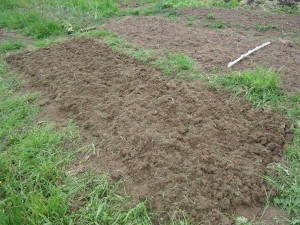The soy beans for the Permaculture Association trials were put in the ground on Wednesday afternoon (21st May – a little later than they should have been, thanks to Post Office shenanigans claiming extra cash before letting me have them).
For the record, the soil texture is silty clay loam (it is well-draining) and it has a pH of 5.75. Optimal soil pH for soy beans is claimed to be 6.3-6.5, although this takes into account what is best for nitrogen-fixation in the soil, and the beans have been sown without the nitrogen-fixing bacteria inoculation (they are not believed to be present in native soils and others do use the inoculation, but the trial is assessing the crops success – or otherwise – without the inoculation). the same source suggests that soy beans will generally perform well between pH 6.0 and 7.0, so we’ll see how mine do a little outside that range.
The beds were prepared in the following way: a plastic membrane mulch (reused from previous operations) was used to clear an area of what had been permanent pasture over late summer and autumn 2013. The area had been of marginal fertility, although I had broadcast some dried seaweed mineral soil treatment and some rock-dust in this area a couple of years ago when I earmarked this plot for vegetable production. Having lifted the membrane in December 2013 I had planned to have spent winter 2013/14 preparing vegetable beds – the ensuing record wet winter rendered the soil too wet to work, and by the time I could work it, weeds had re-established themselves to some extent. A ‘peasant-hoe’ was used to till the soil (by my partner, bless-her – while I was putting in some rabbit fencing) and clumps of weeds were pulled out. A good tilth was created, but as the photo above shows, some remnants of vegetation were left in. This is not an issue, since the beds will be mulched with rotted wood-chips as soon as the beans have got away sufficiently and any weed remnants will go to boosting soil organic matter (they will not be dug into the soil so ‘nitrogen-robbery’ is not expected to be a factor). Less decomposed wood-chips will be used to mulch the surrounding paths after they have been mown – this year’s use of wood-chips for mulching and soil-building is to be the subject of a soon to be written post. The 68 beans supplied were planted in three rows a little less than 2 feet apart, and at 3 inch spacings. Overnight and the following day they were watered in by rain.
I will post updates as and when …
